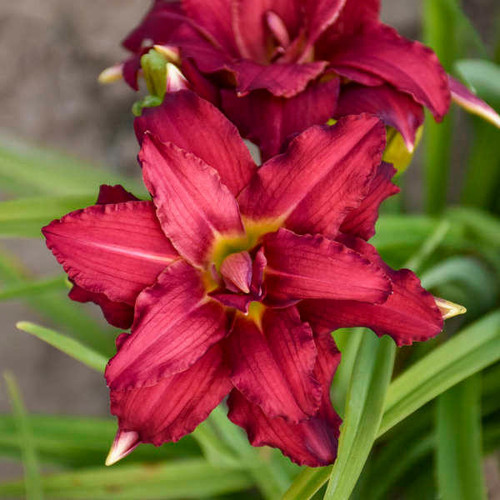Product Description
Hemerocallis 'Pardon Me' Daylily (Apps 1982) (25) Bare Root Plants
- Miniature daylily; 2.75', fragrant, cranberry red tepals with a narrow yellow watermark and bright green throat
- Petals have pie crust ruffled edges, sepals are smooth, both are slightly recurved
- Heavily budded; blooms in Michigan from mid-July to mid-October, and in zones 6-7 it even tends to rebloom
- Nocturnal--tomorrow's blossoms open during the prior evening
- Diploid
Parentage: (sdlg X LITTLE GRAPETTE)
American Hemerocallis Society Donn Fischer Memorial Cup (Best miniature) -- 1986
American Hemerocallis Society Honorable Mention (AHS first stamp of approval) -- 1984
American Hemerocallis Society Award of Merit (Outstanding beauty and performance over a wide area of the country) -- 1987
American Hemerocallis Society Florida Sunshine Cup (Best Small or Miniature) -- 1987
Height: 18 Inches
Spread: 18 - 24 inches
Hardiness Zones: 3,4,5,6,7,8,9
Flower Color: Red shades
Full Sun (> 6 hrs. Direct Sun) to Part Shade (4-6 hrs. Direct Sun)
Low to Average Water Needs
Poor to Fertile Soil Quality
Bloomtime: Midsummer, Rebloomer
Attracts Butterflies and Hummingbirds
Bee Friendly
Rabbit Resistant
Growth Rate: Medium
Border Plant, Mass Planting, Easy To Grow, Salt Tolerant
Enjoy a Season-Long Spectacle of Color with 'Pardon Me' Daylily!
Hemerocallis 'Pardon Me' is a captivating reblooming daylily that demands attention with its vibrant, cranberry-red flowers and its ability to bloom repeatedly throughout the summer. This compact and vigorous perennial is a favorite among gardeners for its long-lasting color and easy-care nature.
'Pardon Me' is a miniature daylily that offers big impact with its profusion of small, but vibrant, cranberry-red flowers. The 2 ¾-inch blooms have a delicate, ruffled edge and a contrasting yellow-green throat, adding a touch of brightness. This daylily is a rebloomer, meaning it produces multiple flushes of flowers throughout the summer, extending its season of interest. The foliage is a healthy green, forming a compact clump that complements the vibrant flowers.
- Mature Size: 18 inches tall, 16-24 inches wide
- Flower Color: Cranberry-red with a yellow-green throat
- Bloom Time: Mid-summer to early fall (reblooming)
- Foliage: Green, arching, strap-like
- Growth Habit: Clump-forming, compact
- Light Needs: Full sun to part shade (at least 6 hours of sun for best blooming)
- Soil Needs: Well-drained soil; adaptable to various soil types
- Hardiness Zones: 3-9 (USDA)
- Special Features: Reblooming, miniature size, showy flowers, fragrant, attracts butterflies
Planting:
- Timing: Plant in spring or fall for best results.
- Location: Choose a sunny to partially shaded spot with well-drained soil. Daylilies thrive in locations that receive at least 6 hours of sunlight.
- Soil Preparation: Amend the soil with compost or other organic matter to improve drainage and fertility.
- Spacing: Space plants 12-18 inches apart to allow for adequate growth.
- Planting Depth: Plant the crown (where the roots meet the foliage) at the same depth as it was in the container.
- Watering: Water thoroughly after planting and regularly until it is established.
Care:
- Watering: Once established, 'Pardon Me' is relatively drought-tolerant, but it will bloom best with consistent moisture. Water deeply during prolonged dry spells.
- Fertilizing: Apply a balanced fertilizer in early spring to promote vigorous growth and abundant blooming.
- Deadheading: Removing spent flowers (deadheading) can improve the plant's appearance and encourage reblooming.
- Dividing: Divide clumps every 3-5 years to prevent overcrowding and rejuvenate the plant. This is best done in spring or fall.
- Pest and Disease Control: 'Pardon Me' is generally pest and disease resistant.
Uses in the Garden:
- Small Gardens and Containers: Its compact size makes it ideal for smaller gardens or container plantings.
- Borders and Edging: Adds a vibrant pop of color to borders and edges along pathways or flower beds.
- Mass Plantings: Plant in groups for a stunning display of cranberry-red blooms.
- Mixed Borders: Combines beautifully with other perennials and shrubs.
- Focal Point: The eye-catching red flowers can serve as a focal point in a smaller garden.
Enjoy a season-long spectacle of color with the reblooming and vibrant Hemerocallis 'Pardon Me'!
Other Details
The most important part of the plant is its root system. Healthy roots are the foundation of a healthy, vibrant plant. The type of plug container used is based on the specific needs of the plants. Perennials offered as bare root traditionally perform better when planted as bare root.Planted in a specialized mix, potted plants have well established root systems. Top growth stage will vary depending on the current life cycle and time of year when shipped. In Winter and early Spring dormant plants may be shipped. Dormant plants may be planted right away, even before the last frost date.
Most bare root varieties are field grown for at least one season, though Hemerocallis and Hosta are grown for two seasons. The bulk of the soil is removed during the harvesting process and the tops of most varieties are trimmed back to the crown. They are graded, packed in shredded aspen or sphagnum moss and stored in freezers until ready to be shipped.
See our Container Sizes and Bare Root Perennials pages for more information.
Plant information and care is provided in the Overview section, Plant Genus Page and general information is provided in the Planting Care & Guides. Additional questions can be asked on each Plant page.
Plant Spacing: Using the maximum mature spread or width of a plant to guide spacing, ensures space to grow to full size. To fill an area sooner, plant them closer together. Just remember, future thinning or transplanting may be needed.
Water: Keep a close eye on newly planted perennials, especially throughout the first growing year. Most early plant loss is due to too much or too little water!
















